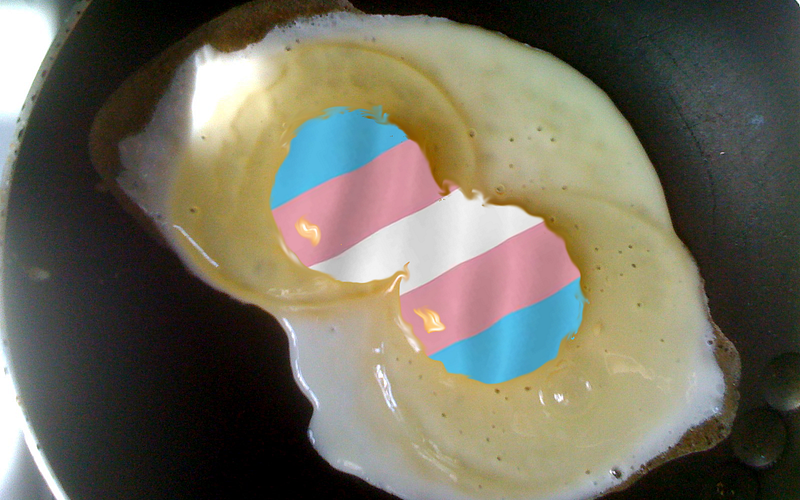The Transgender Brain: Its Development and Operation
The gender-critical crowd dismisses the transgender experience as delusion.


Generally, conservative rhetoric invalidates LGBTQ experiences by disregarding each as a voluntary — and erroneous — choice. The rhetoric demands that sex, sexuality, and gender follow solely from genetics and its associated biochemical processes. The logical conclusion is that — because LGBTQ experiences are the exception, and all humans are equivalent biologically — there must be something wrong with those people.
The LGBTQ community also clings to studies that appear to indicate a biological basis for their experiences. Brain studies claim to explain that transgender people are just like “normal” cisgender people — at least inside their heads. The logical conclusion is that — even if LGBTQ experiences are the exception, since all humans are equivalent biologically — these studies “prove” there must be nothing wrong with those people.
Unfortunately, both views are inaccurate.
Human brain development
Human brain structure begins with genetics. The blob of protoplasm that will become a brain begins developing by the beginning of the third week of an embryo’s fertilization [1]. By the end of the fourth week, the blob has differentiated enough to distinguish primary brain structures [2].
Thousands of genes contribute to building an infant’s brain [3]. Our understanding of the process is limited — the human genome contains on the order of 30,000 genes [4] that interact in a complicated pattern during embryo development. One thing is certain, however: while genetics initiates brain development, the role biology plays wanes quickly.
At birth, a human infant possesses a far greater number of neurons than an adult does [3]. As the infant interacts with its environment after birth, the brain undergoes a process called “pruning,” in which neural patterns solidify and unnecessary neurons are broken down. Pruning requires experience — the brain will not develop to its fullest without sensory and cognitive stimulus [5]. The result depends not only upon the probability inherent in genetics, but also the unique experience of the infant interacting with its environment.
Does brain structure define thought?
Do our thoughts and emotions, the specific likes and dislikes that make us who we are, spring purely from brain structure and neural patterns established early in our development? Attempts to locate emotions in the brain are largely unsuccessful, although activity in certain structures is loosely associated with experiences of happiness or sadness [6].
Debate around the relative influence of Nature (genetics and biochemistry) and Nurture (interaction with socio-environmental factors) continues unabated [5]. Although thought and emotions have eluded scientific characterization at the time of writing, evidence that richer experiences result in greater brain development continues to spur research into the physical basis for human expression [7]. In particular, neuroscience attempts to correlate brain activity with cognitive activity.
Functional MRI
Studying human brains presents a singular challenge in scientific ethics. Functional Magnetic Resonance Imaging (fMRI) promises insight into brain activity as it occurs — all without inconvenient uterine electrodes [8]!
fMRI uses proton Nuclear Magnetic Resonance (NMR) to measure blood flow to locations in the brain [9]. In brief, the extent of hemoglobin oxygenation affects how protons in water molecules react to an external magnetic field — more hemoglobin oxygenation causes less proton magnetic susceptibility. A quirk in human brain activity is that blood flow occurs faster than metabolism during neuronal activity — more blood flow and more oxygenation — resulting in a higher NMR signal. The difference between the proton NMR signal during activity and at rest generates an fMRI image.
Unfortunately, the analytical methodology used in fMRI studies has been plagued with issues. The brain is never completely at rest — the accuracy of baseline activity depends on several factors, including the environment, the subject, the MRI instrument, and the operator [10].
Blood flow is also much slower than physical motion, let alone thought or emotions. Where thoughts come and go many times in an instant, blood flow occurs on the order of seconds — up to 6 to 10 seconds. fMRI may not be capable of measuring changes at high enough resolution [10].
Finally, critics question the quality of data from fMRI studies. A bug in the software used to perform statistical analysis may invalidate as many as 40,000 studies published before 2015 [11]. Most concerning is a “study” performed on a dead salmon that appears to provide data similar to those from live humans [12].
Does this mean, baby, I WASN’T born this way?
Although blood flow to the brain appears to correlate with physical activity and some high-level emotional experiences, it is unclear whether fMRI can measure specific thoughts and emotions. Does neuronal activity correlate directly with emotions? With thoughts? With the complex of emotions and thoughts expressed within a society that implies an identity?
Psychiatrists find evidence of genes that correlate with mental disorders, yet all have proven to be minor contributors (< 5% increase) in the probability of developing the disorder [13]. No genetic test exists even to diagnose depression — the most common and well-studied mental disorder [14]. While it may be possible that genetics contributes to identity, no hard evidence exists. Until that evidence exists, the questions above remain unanswered.
As a result, none of the discussion above implies that any sexual or gender experience is invalid. On the contrary, they are life experiences that clearly exist and must be honored. Whether or not there is a clear explanation for why experiences occur is less relevant than that they occur.
To return to the gender critical arguments at the beginning of this article, I reject the assertion that sex identity and gender identity spring purely from biology. Identity is formed through the interactions among biology, psychology, and their expressions within a society, quickened by a consciousness that exists outside the influence of all three. But my purpose in writing this article goes beyond the attempt to sully inconclusive science further.

The attempt to invalidate LGBTQ experiences demands that sex, sexuality, and gender follow solely from genetics and its associated biochemical processes. Implicit in this demand is acceptance that the cisgender and heterosexual experiences are “proved” valid by genetics and biochemistry. But nothing in scientific literature indicates that any experience is validated by genetics and biochemistry — not the transgender or homosexual experiences, and also not the cisgender or heterosexual experiences. Instead, the argument assumes what is common and frequent is also “normal,” and any deviation may be explained away by delusion.
When we in the LGBTQ community hope to argue for our validation with weak scientific evidence, we accept the false axiom that identity may be derived from biochemistry at all. As long as we accept the logical fallacy in the rhetoric, we give our opponents control over the discussion, and we cannot prevail. The deck is stacked against us as we fight for our existence with the shoddy weapons given to us by our opponents. Our only recourse is to reject the argument completely until its proponents provide evidence of its truth. Until then, any discussion must take the following (whimsical) format of my interview with Matt Walsh:
Amethysta Herrick: So, Matt, you say you “just know” your gender? You have no hard proof of it?
Matt Walsh: Yeah, pretty much.
AH: Wow, that’s exactly how I feel. And you say you couldn’t choose to be homosexual? It’s hetero all the way?
MW: Oh, heck, yeah, baby!
AH: Well, how ‘bout that? It’s a common experience with us, too. Last question, Matt — do you think you can tell who you are without my input?
MW: What? Of course I can!
AH: This is crazy, Matt! It’s like we could be brothers. That is, if I didn’t identify as a woman. And if I believed even my family could churn out a wanker of your magnitude.
MW: Wow, thanks, that’s very ki…wait, what?
AH: I’m sorry, Matt, that’s all the time we have. To everybody in our audience: good night and good news.




